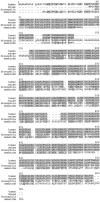Identification of a novel gene on chromosome 7q31 that is interrupted by a translocation breakpoint in an autistic individual
- PMID: 10889047
- PMCID: PMC1287197
- DOI: 10.1086/303005
Identification of a novel gene on chromosome 7q31 that is interrupted by a translocation breakpoint in an autistic individual
Abstract
The results of genetic linkage studies for autism have suggested that a susceptibility locus for the disease is located on the long arm of chromosome 7 (7q). An autistic individual carrying a translocation, t(7;13)(q31.3;q21), with the chromosome 7 breakpoint located in the region of 7q implicated by genetic studies was identified. A novel gene known as "RAY1" (or "FAM4A1") was found to be directly interrupted by the translocation breakpoint. The gene, which was found to be encoded by 16 exons with evidence of alternative splicing, spanned > or =220 kb of DNA at 7q31.3. Mutation screening of the entire coding region in a set of 27 unrelated autistic individuals failed to identify phenotype-specific variants, suggesting that coding region mutations are unlikely to be involved in the etiology of autism. Apparent homologues of RAY1 have also been identified in mouse, rat, pig, chicken, fruit fly, and nematode. The human and mouse genes share similar splicing patterns, and their predicted protein products are 98% identical.
Figures



Comment in
-
Chromosome 7q: where autism meets language disorder?Am J Hum Genet. 2000 Aug;67(2):278-81. doi: 10.1086/303034. Epub 2000 Jul 7. Am J Hum Genet. 2000. PMID: 10889044 Free PMC article. No abstract available.
References
Electronic-Database Information
-
- The Chromosome 7 Project, http://www.genet.sickkids.on.ca/chromosome7/ray1primers/ (for primer sequences and PCR sequences for mutation analysis of individuals exons on RAY1 [FAM4A1])
-
- GenBank, http://www.ncbi.nlm.nih.gov/Genbank/ (for BAC clone H_RG114A06 [accession number AC002542], RAY1 and mray [FAM4A1 and Fam4a1; accession numbers AF234882–AF234886], and H_N0032P06, cos14c9, and cos19d10 [accession numbers AZ081238 and AZ254572–AZ254575])
-
- Genetic Location Database, The, http://cedar.genetics.soton.ac.uk/public_html/ldb.html
-
- Online Mendelian Inheritance in Man (OMIM), http://www.ncbi.nlm.nih.gov/Omim/ (for AD [MIM 209850], SPCH1 [MIM 602081], and HTR2A [MIM 182135])
References
-
- Ashley-Koch A, Wolpert CM, Menold MM, Zaeem L, Basu S, Donnelly SL, Ravan SA, et al (1999) Genetic studies of autistic disorder and chromosome 7. Genomics 61:227–236 - PubMed
-
- Barrett S, Beck JC, Bernier R, Bisson E, Braun TA, Casavant TL, Childress D, et al (1999) An autosomal genomic screen for autism: Collaborative Linkage Study of Autism. Am J Med Genet (Neuropsychiatr Genet) 88:609–615 - PubMed
-
- Bolton P, Pickles A, Butler L, Summers D, Webb T, Lord C, Le Couteur A, et al (1992) Fragile X in families multiplex for autism and related phenotypes: prevalence and criteria for cytogenetic diagnosis. Psychiatr Genet 2:277–300
-
- Fisher SE, Vargha-Khadem F, Watkins KE, Monaco AP, Pembrey ME (1998) Localisation of a gene implicated in a severe speech and language disorder. Nat Genet 18:168–170 - PubMed
Publication types
MeSH terms
Substances
Associated data
- Actions
- Actions
- Actions
- Actions
- Actions
- Actions
- Actions
- Actions
- Actions
- Actions
- Actions
- Actions
LinkOut - more resources
Full Text Sources
Other Literature Sources
Molecular Biology Databases

